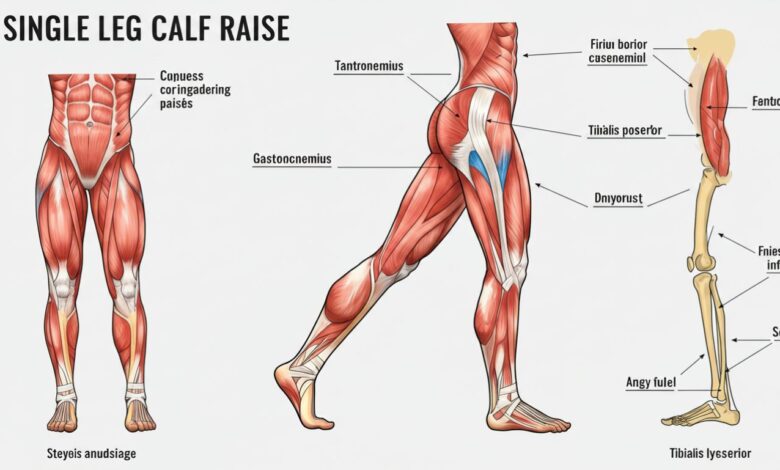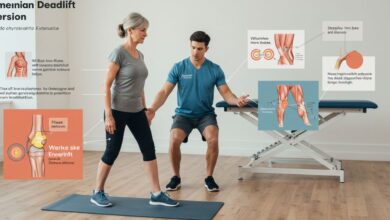The Single Leg Calf Raise Explained

What is Single Leg Calf Raise Exercise?
Table of Contents
The single leg calf raise is a simple yet effective exercise that involves standing on one leg and lifting the heel off the ground while keeping the toes firmly planted. The purpose of this exercise is to strengthen the gastrocnemius muscle, which is one of the major muscles in the lower leg. The gastrocnemius muscle is important for walking, posture, and movements like running and jumping. It aids in ankle movement and knee flexion, making it an essential muscle for overall lower limb stability.
Importance of Targeting the Gastrocnemius Muscle
The gastrocnemius muscle, also known as the calf muscle, is responsible for generating the power needed for activities such as walking, running, and jumping. It consists of two heads, the medial head and the lateral head, which originate from the femur and insert into the Achilles tendon. By targeting the gastrocnemius muscle through exercises like the single leg calf raise, physiotherapists can help improve its strength and function, leading to better ankle and knee stability.
How the Exercise Enhances Ankle Movement and Knee Flexion?
The single leg calf raise exercise specifically targets the gastrocnemius muscle and requires it to contract concentrically to lift the heel off the ground. This movement enhances ankle movement by strengthening the muscles responsible for plantar flexion, which is the action of pointing the foot downward. Ankle movement is closely linked to knee flexion, as the gastrocnemius muscle crosses both the ankle and knee joints. By strengthening the gastrocnemius muscle, the single leg calf raise exercise can improve knee flexion and overall lower limb function.
Potential Benefits for Overall Lower Limb Stability
Apart from targeting the gastrocnemius muscle, the single leg calf raise exercise has additional benefits for overall lower limb stability. It engages other muscles in the lower leg, such as the soleus muscle and the tibialis posterior muscle, which contribute to ankle stability and control. Improved ankle stability can help prevent ankle sprains and other injuries during daily activities and sports. Additionally, the exercise improves proprioception, which is the body’s ability to sense its position in space. This can further enhance balance and coordination, reducing the risk of falls and improving overall lower limb stability.
How Merlin Physio App helps with Knee Problems
The Merlin Physio app is a valuable tool for individuals dealing with knee troubles, particularly when it comes to exercises like the Single Leg Calf Raise. Here’s how Merlin Physio can be a helpful companion in this specific scenario:
- 1. Customized Exercise Plans: Merlin Physio allows physiotherapists to create customized exercise plans tailored to the individual’s specific knee issues. For someone with knee troubles, the app can generate a plan that includes the Single Leg Calf Raise at an appropriate difficulty level.
- 2. Progress Tracking: The app helps in tracking progress over time. For Single Leg Calf Raises, this means monitoring how well the individual can perform the exercise and how it affects their knee. It keeps a record of each session, making it easy to see improvements or identify any issues.
- 3. Real-Time Feedback: Merlin Physio offers AI-powered real-time feedback. During the Single Leg Calf Raise, it can analyze the individual’s form and provide immediate guidance to ensure they are performing the exercise correctly and without putting excessive strain on the knee.
- 4. Goal Setting: Users can set goals within the app. For those with knee troubles, this might involve gradually increasing the number of repetitions or the depth of the exercise. The app keeps them motivated by showing progress towards these goals.
- 5. Communication with the Physiotherapist: Merlin Physio enables communication between the patient and their physiotherapist. If someone experiences discomfort or has questions while doing Single Leg Calf Raises, they can easily reach out to their physiotherapist for guidance and adjustments.
- 6. Preventing Further Knee Issues: By closely monitoring the progress of Single Leg Calf Raises, physiotherapists can ensure that the exercise is helping to strengthen the calf muscles without exacerbating knee troubles. This proactive approach can prevent further complications down the road.
How to Perform Single Leg Calf Raise Exercise?
To perform the single leg calf raise exercise correctly, follow these step-by-step instructions:
- Stand on a step with one leg, positioning your heel over the edge.
- Maintain an upright body posture with your head aligned with your spine.
- If needed, use support for balance.
- Keep the knee straight and facing forward.
- Lift the heel as high as possible, pausing at the end of each movement.
- Slowly return to the starting position, preventing the heel from dropping below the step.
- Ensure the knee stays straight, and the heel faces backward to avoid foot rotation.
- To intensify the exercise, hold a weight in one hand.
- For an easier version, use your arms for support.
- Breathe consistently, avoiding breath-holding.
- Perform the movement within your comfort and pain limits, following guidance from your physiotherapist.
Indications for Using the Single Leg Calf Raise Exercise
A. Common Knee Problems that can be Treated with this Exercise
The single leg calf raise exercise is often recommended by physiotherapists for various knee problems. Some of the common conditions that can benefit from this exercise include:
- Patellofemoral Pain Syndrome: This condition is characterized by pain around or behind the kneecap and is often caused by imbalances in muscle strength and flexibility. Strengthening the gastrocnemius muscle through the single leg calf raise exercise can help improve patellar tracking and reduce knee pain.
- Runner’s Knee (Iliotibial Band Syndrome): This condition is common among runners and is characterized by pain on the outer side of the knee. Strengthening the lower leg muscles, including the gastrocnemius, can help alleviate the stress placed on the knee joint during running and prevent further discomfort.
- Patellar Tendinopathy (Jumper’s Knee): This condition is characterized by pain and inflammation in the patellar tendon, which connects the kneecap to the shinbone. Strengthening the gastrocnemius muscle can help offload the patellar tendon and provide support to the knee joint during activities that involve jumping and landing.
B. Evaluation and Assessment by a Physiotherapist to Determine Exercise Appropriateness
Before prescribing the single leg calf raise exercise, a physiotherapist will conduct a thorough evaluation and assessment of the patient’s knee condition. This assessment may include a physical examination, a review of the patient’s medical history, and possibly imaging tests such as an MRI or ultrasound. Based on the findings, the physiotherapist will determine if the single leg calf raise exercise is appropriate and safe for the patient.
C. Conditions that May Benefit from this Exercise
In addition to the specific knee problems mentioned earlier, the single leg calf raise exercise can also benefit individuals who are recovering from knee surgery or experiencing general knee weakness. Strengthening the gastrocnemius muscle can help improve overall lower limb stability and function, which is essential for a successful rehabilitation process.
